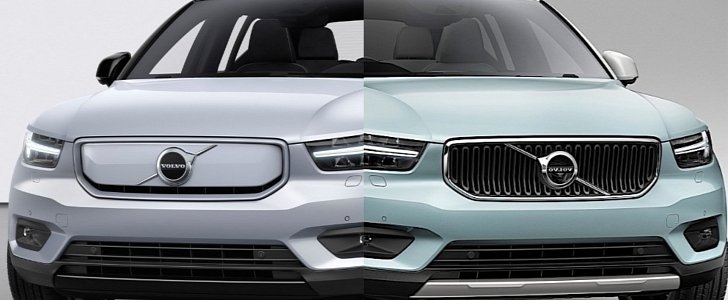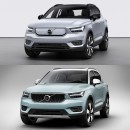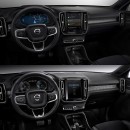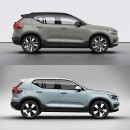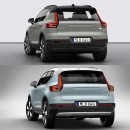This week, Swedish carmaker Volvo officially entered the electric car market with the launch of the XC40 Recharge, the battery-powered version of the 2-year old small SUV. The two share a lot of parts, from the new modular architecture to the interior layout, but given their different powertrains, they don’t look exactly the same.
The two Volvos are identical when it comes to shape, proportions and space, but the exterior is not the identical, given the more relaxed requirements of having it run on something other than exploding fuel.
At the front, the most noticeable difference is the absence of the car’s grille, with its chromed bars. In its place, Volvo fitted a full body panel, behind which are hidden the sensors used by the car’s driver assistance systems.
Unseen to the naked eye is the absence of an engine, which has been replaced with a frontal trunk that can hold up to 30 liters of cargo.
From the side, the two cars look exactly the same, and so do when looked at from the rear as well. For obvious reasons, the Recharge variant of the XC40 lacks any tailpipes, and that should give it a special look compared to the regular car.
Only it doesn’t, because the tailpies are hidden out of view in the ICE-powered SUV as well.
The interior is the same at least when talking about general design, materials used and the space available. There are the same vertical touchscreen and the digital instrument cluster, albeit the latter does seem to have some extras when it comes to configuration.
Unlike its older sibling, the XC40 Recharge runs a new version of Google’s Android, making it the first car in the Swedes’ lineup capable of receiving large over-the-air updates.
Visual changes aside, the new EV presents itself as a suitable candidate to the list of best selling electric SUVs, as it offers a range of over 400 km (248 miles). That’s precisely the same as the Audi e-tron and less than the capabilities of the Tesla Model X and Jaguar I-Pace.
At the front, the most noticeable difference is the absence of the car’s grille, with its chromed bars. In its place, Volvo fitted a full body panel, behind which are hidden the sensors used by the car’s driver assistance systems.
Unseen to the naked eye is the absence of an engine, which has been replaced with a frontal trunk that can hold up to 30 liters of cargo.
From the side, the two cars look exactly the same, and so do when looked at from the rear as well. For obvious reasons, the Recharge variant of the XC40 lacks any tailpipes, and that should give it a special look compared to the regular car.
Only it doesn’t, because the tailpies are hidden out of view in the ICE-powered SUV as well.
The interior is the same at least when talking about general design, materials used and the space available. There are the same vertical touchscreen and the digital instrument cluster, albeit the latter does seem to have some extras when it comes to configuration.
Unlike its older sibling, the XC40 Recharge runs a new version of Google’s Android, making it the first car in the Swedes’ lineup capable of receiving large over-the-air updates.
Visual changes aside, the new EV presents itself as a suitable candidate to the list of best selling electric SUVs, as it offers a range of over 400 km (248 miles). That’s precisely the same as the Audi e-tron and less than the capabilities of the Tesla Model X and Jaguar I-Pace.
